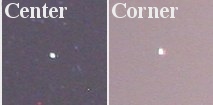Sigma 10 mm f/2.8 EX DC FISHEYE HSM
7. Coma and astigmatism
Please Support UsIf you enjoy our reviews and articles, and you want us to continue our work please, support our website by donating through PayPal. The funds are going to be used for paying our editorial team, renting servers, and equipping our testing studio; only that way we will be able to continue providing you interesting content for free. |
- - - - - - - - - - - - - - - - - - - - - - - - - - - - - - - - - - - - - - - - - - - - - - - -
When you measure the coma level, the hard part begins again. If we wanted to do it traditionally, putting the diode in a fixed distance from the lens, there would be problems with the sharpness plane shift with the diode once in the frame center and once in the frame corner. We would have to put the diode in infinity to fix that obstacle. Nature lent a helping hand to us here, offering almost ideal point light sources in the near infinity – the stars. A simple night sky picture and then picking some bright stars in the center and in the corner allows us to assess the coma in a quick way, which is very well-controlled to our satisfaction.

It’s difficult to say anything bad about the astigmatism correction level – it reached 4.7% and all the results below 5% are considered to be very good.






